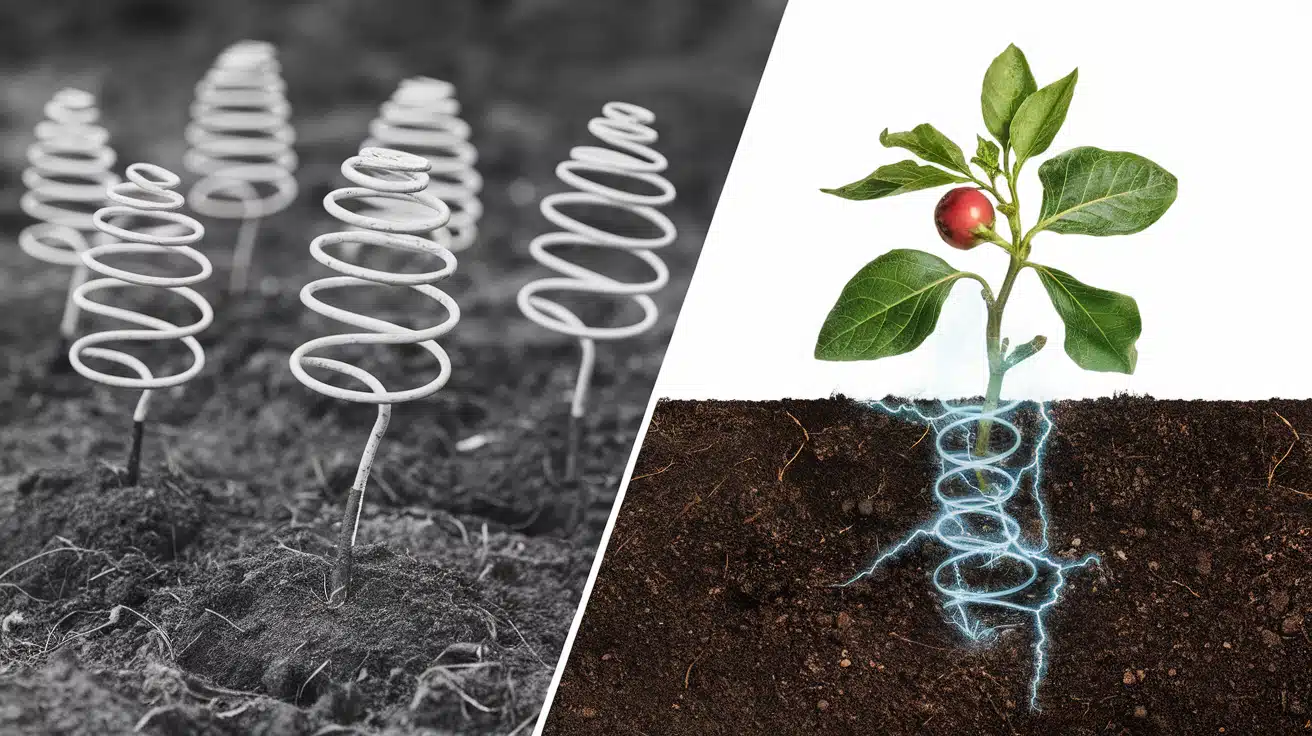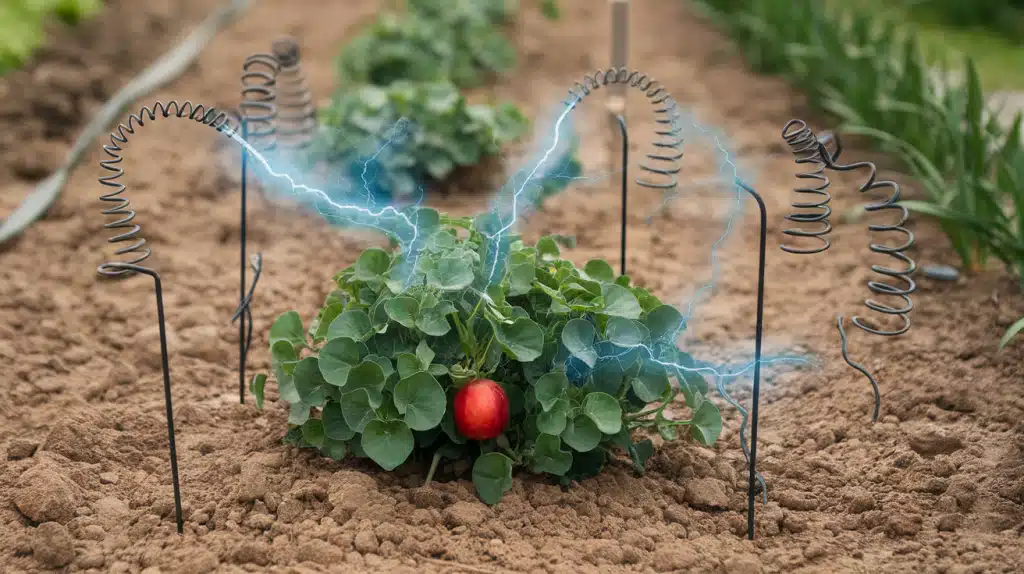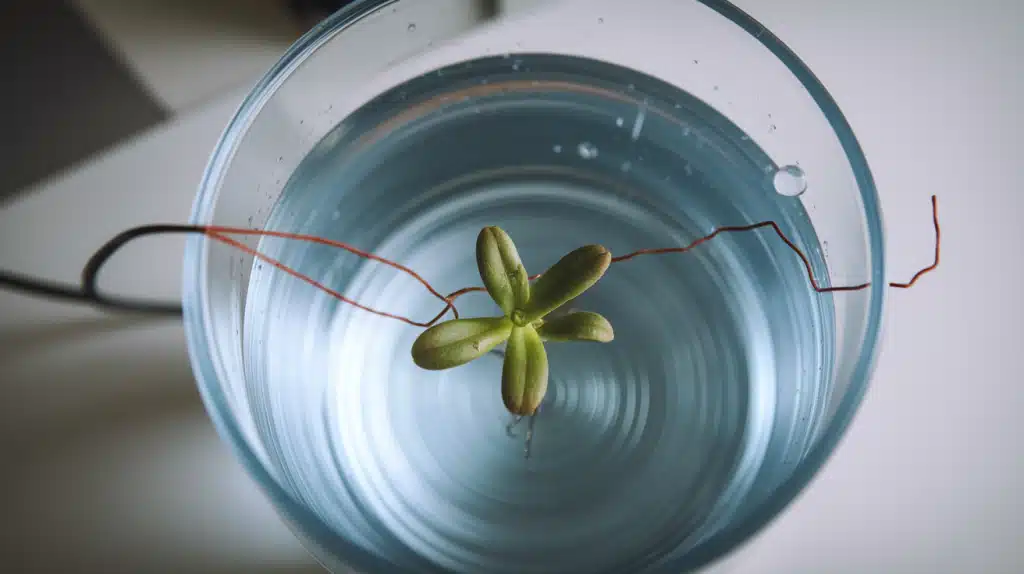Are you tired of spending hundreds on fertilizers and pesticides only to watch your plants struggle with poor growth and pest problems?
Many gardeners feel frustrated when conventional methods fail to produce the abundant harvests they dream of achieving.
Electroculture gardening provides a natural solution that harnesses atmospheric energy and utilizes simple copper setups to enhance plant growth by 30-50% without the need for chemicals or expensive inputs.
This guide will explain what electroculture is, how it interacts with Earth’s magnetic field, the two main techniques you can try, and the real benefits, including faster growth, higher yields, and pest resistance, as well as the scientific debate surrounding this centuries-old practice.
What is Electroculture Gardening?
Electroculture gardening is a farming method that uses copper wires, wooden poles, and simple antennas to capture natural energy from the atmosphere. This practice began in the 1700s when scientists first observed that plants grew better near electrical sources.
Unlike regular gardening, which relies on fertilizers and chemicals, electroculture works by placing copper structures in the soil to collect atmospheric electricity and energy from the Earth’s magnetic field.
The theory suggests that this natural energy helps ionize the air around plants, boosts beneficial soil bacteria, and enhances nutrient absorption, resulting in more vigorous and healthier plants without the need for synthetic inputs.
Types of Electroculture Techniques
- Passive electroculture utilizes copper wire antennas and spiral rods that collect natural atmospheric energy, eliminating the need for an external power source, making it ideal for beginners and organic gardeners.
- Active electroculture utilizes small electric devices or battery-powered units that generate controlled electrical charges to stimulate plant growth, making it ideal for commercial growers seeking faster results.
Benefits of Electroculture Gardening
- Faster Plant Growth – Many gardeners report that plants grow 30-50% quicker when copper antennas help capture atmospheric energy for improved cell development.
- Higher Yields – Tomatoes, peppers, and fruit trees often produce more harvest per season due to improved flowering and fruiting cycles.
- Improved Germination Rates – Seeds planted near electroculture setups sprout faster and show better survival rates compared to conventional planting methods.
- Enhanced Nutrient Absorption – Plants can uptake minerals more effectively from soil, reducing your need for expensive fertilizers by up to 50%.
- Reduced Pest Infestation – The electromagnetic field around copper structures may naturally repel aphids, slugs, and other common garden pests.
- No Chemical Inputs – This method supports completely organic gardening, eliminating the need for synthetic pesticides, herbicides, or chemical fertilizers.
- Improved Soil Microbiology – Beneficial bacteria and earthworms thrive more effectively in electroculture gardens, resulting in richer, darker soil over time.
- Eco-Friendly and Sustainable – Uses only natural earth energy and magnetic fields, making it perfect for environmentally conscious gardeners.
- Cost-Effective – Simple copper wire and wooden stakes cost under $20 and last for years without replacement or maintenance.
- Weather Resilience – Plants develop stronger root systems that can better handle drought stress and heavy rains compared to conventionally grown plants.
Scientific Evidence and Effectiveness of Electroculture
1. Limited Peer-Reviewed Studies
While electroculture research from the 1700s and 1800s showed promising results, modern universities rarely study this method. Most agricultural scientists focus on chemical fertilizers and conventional farming techniques instead.
The lack of recent academic research creates doubt among experts and farming professionals. The gap between historical evidence and current scientific validation remains a significant challenge to the acceptance of electroculture.
2. Ongoing Independent Experiments
Thousands of home gardeners are experimenting with electroculture methods and sharing their results on YouTube and gardening forums. Permaculture farms across Europe and North America document plant growth improvements with photo evidence.
Many beginners start small trials in backyard vegetable gardens to test the claims for themselves. These grassroots experiments provide valuable real-world data that academic studies currently lack.
3. Diverse Anecdotal Success
Online testimonials show impressive before-and-after photos of plants grown with copper antenna systems. Gardeners report 40-60% larger harvests from tomatoes, peppers, and leafy greens using electroculture methods.
Many users notice faster seed germination and more vigorous plant stems within just a few weeks. Social media groups dedicated to electroculture share thousands of success stories from different climates and soil types.
4. Placebo or Physics?
Critics suggest that gardeners who try electroculture pay more attention to their plants, leading to better care. Some scientists argue that natural weather variations or improved watering habits cause the reported growth improvements.
The lack of controlled studies makes it hard to separate real electroculture effects from other factors. This debate continues as more people experiment with the technique in their own gardens.
5. Influencer-Driven Popularity
TikTok and Instagram videos about electroculture have gained millions of views, sparking interest among younger gardeners. Popular homesteading channels on YouTube feature electroculture experiments that inspire viewers to try the method.
Social media influencers often show dramatic plant growth results that go viral within gardening communities. This online buzz has introduced electroculture to people who have never heard of the technique before.
6. Natural Energy vs. External Input Debate
Agricultural experts worry that gardeners might abandon proven fertilizers and pest control methods for unproven techniques. Some soil scientists support electroculture as a supplementary tool alongside organic farming practices rather than a replacement.
Extension offices and gardening educators take a cautious approach, recommending traditional methods first. The debate centers on whether natural energy methods can truly replace modern agricultural inputs.
7. Mindset and Observation-Driven
Many electroculture practitioners become more observant gardeners, checking plants daily and noting small changes in growth. This increased attention often leads to more effective watering schedules, earlier pest detection, and overall improved plant care.
The ritual of setting up copper antennas creates a stronger connection between gardeners and their plants. Even skeptics acknowledge that the practice encourages more mindful and engaged gardening habits.
Is Electroculture Right for You?
Electroculture gardening is best suited for curious gardeners willing to experiment with natural methods, particularly those practicing organic or permaculture farming who aim to reduce chemical inputs.
The setup costs under $20 and takes just 30 minutes to install copper antennas, making it perfect for budget-conscious home gardeners.
While results aren’t guaranteed and scientific proof remains limited, the low investment and potential benefits make electroculture worth trying if you enjoy testing new gardening techniques, but don’t rely on it as your only growing method until you see proven results in your garden.
Wrapping It Up
Electroculture gardening presents an intriguing approach to enhancing plant growth by harnessing natural atmospheric energy and utilizing simple copper wire setups.
The main benefit lies in electroculture’s simplicity and low cost. For under $20, you can set up copper antennas that may improve your garden’s productivity for years.
Even if the electrical effects prove minimal, the practice encourages better plant observation and more mindful gardening habits.
So what’s next? Start small with a few copper wire antennas in one garden bed and document your results.
Take photos, measure growth rates, and compare harvests with your conventional plants. Join online electroculture communities to share your experience and learn from other gardeners.
Ready to try this natural gardening method? What plants will you test electroculture on first?
Frequently Asked Questions
Does Electroculture Gardening Work?
Many gardeners report 30-50% better growth and yields, but scientific proof is limited; results vary by location, soil type, and setup quality.
Does Copper Wire Help Plants Grow?
Copper wire may capture atmospheric electricity and create beneficial electromagnetic fields around plants, though experts debate whether this truly affects growth.
How to Electroculture Gardening?
Insert copper wire antennas or spiral rods into your garden soil near plants – no power source is needed; just let natural energy do the work.




